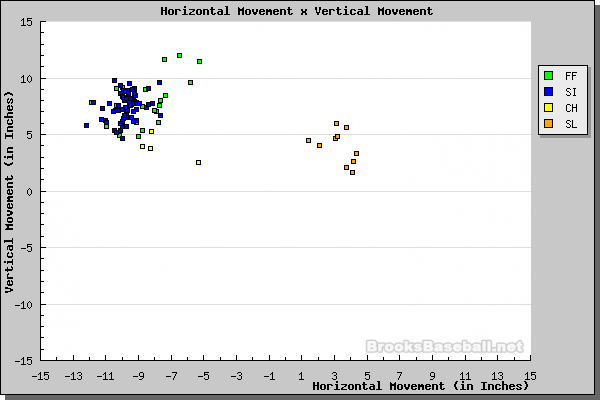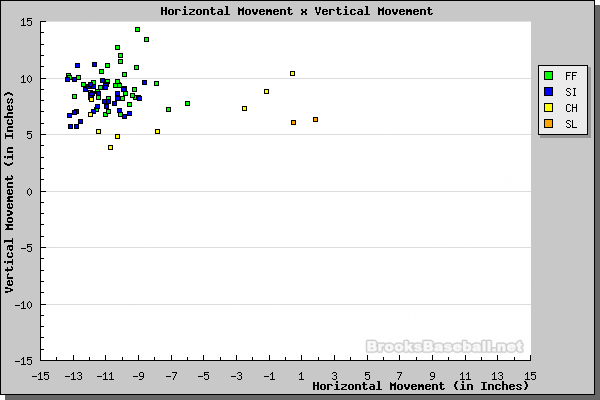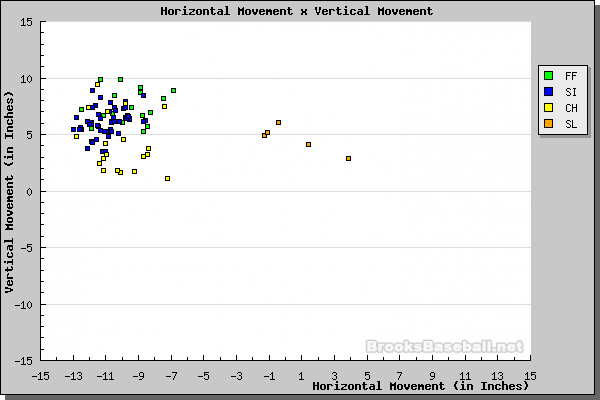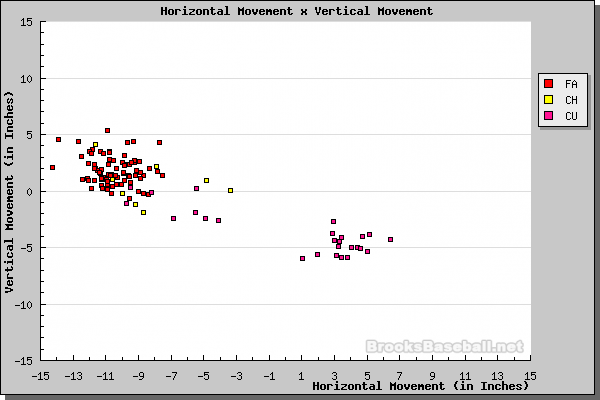Newer Slimmer Carlos Silva’s missing sinker
Ignore the possible issues with Gameday’s pitch classification. What about the fact that Silva’s sinker is exactly the same pitch as his fastball? Does it matter if he mixes them if they produce the same results?
Here’s some graphs off my new favorite tool, the BrooksBaseball PitchFX Tool
Carlos Silva’s sinker is indistinguishable from his fastball, if we grant that he even throws two pitches. He’s playing rock-paper-scissors with rock, rock, and rock.
Not that that kind of clustering is at all unusual. Here’s what a pitcher who can throw a sinker looks like:
That’s Webb, of course, in a stellar start. I recommend checking out all of those graphs for a neat compare-and-contrast against Silva’s start today.
Webb’s got a better spread of movement, and a secondary pitch that’s clearly different. Silva doesn’t. Check out, say, that colorcoded break chart. You can see that not only does Webb get more varied movement and have two distinct, different pitches while Silva’s pretty much throwing the same speed and getting the same break.
If you didn’t know what Silva was supposedly throwing, and you eyeballed his break chart (see this rough reference guide), you’d think he was throwing nothing but two-seam fastballs. Looking at Webb, an actual sinkerballer, he’s getting the kind of movement you’d associate with a changeup… at 90mph.
So you’re thinking “that’s not fair, comparing Silva to Webb”. And it’s not, because Webb is good, but beyond that, pick any effective sinkerball pitcher and look at what they’re throwing. They’re getting better movement and throw at least two distinct pitches.
Silva has one pitch, and it’s hittable. I don’t care if he’s got nine grips or arm actions or whatever: they results are all the same. Maybe he should try something else. Like retiring.
I know, I’m bitter. I just watched him pitch, you should sympathize.
Comments
16 Responses to “Newer Slimmer Carlos Silva’s missing sinker”
Leave a Reply
You must be logged in to post a comment.





I was at the game, and it was absolutely brutal. Silva is terrible.
What’s worse is our offense might be just as bad, if not worse. 🙁
I love this tool.
Seriously, this thing is awesome.
It shows what was pretty evident, which is last night (4-18). Bedard, especially, though. There were 5 or 6 legit strikes, especially low, that were called balls.
One frightening thing is the number of swing strikes by the M’s against Edwin Jackson, especially those that are low. 11 or 12 pitches out of the strike zones, most of them WELL out of the strike zone, that the M’s swung at.
Compare that to Fatboy Slim, which through about the same number of low balls today, but only got 2 swinging strikes.
However, if you want to see a pitcher who gets a massive strike zone, look at games pitched by Mariano Rivera. The strike zone this guy gets is MASSIVE. In one game he got a 30″ strike zone. Yikes.
If you can’t say anything nice about Carlos Silva or Bill Bavasi, don’t say anything at all. . .
Possibly a dumb question, but what do B, S, and X represent?
Ball, Strike & In Play.
For my own well being, I planned before the season to watch as few games with Silva as possible.
Thank you for the highlights, I don’t need to know anymore.
My kids call Silva’s pitch the “Marinara” – as in Meatball.
Either I’m being dense, or I’m not reading these charts correctly…to me it looks like Webb’s change and his fastball are pretty much mixed right in on top of each other, just like Silva’s fastball, sinker, and change. They both have a clearly different pitch (Silva’s slider, Webb’s curve).
Not being dense, but not looking at the right thing.
What you should see is the “smear” of pitches. A good sinkerball pitcher should have a huge variety of pitches that sink, or stay, and have less horizontal movement, as they sink.
Fatboy Slim, however, has the perfectly round “shotgun” of fastballs/sinkers.
Additionally, look at how little hit sinkers actually sink. Not at all. Not a single pitch had a downward motion.
Other than him retiring, there really is no way out of this contract, is there?
could he possibly be even a little useful out of the bullpen? I mean we have to pay him no matter what…
Maybe he could be the team cook. Is there anything in his contract that says he has to actually be on the team? I mean, if we’re going to pay him, perhaps he could shag golf balls for Griffey on the driving range.
I think I need someone who really understands this stuff give me a tutorial. I suppose that I can grasp that a fastball moves “up” and “in” toward a RHB, but it’s a hard concept to grasp that Webb’s sinker is actually “lower” on the movement scale than Silva’s.
Also, it’s weird that a curveball actually registers less movement than a fastball does.
I saw last week Mike Fast took down his pitch f/x player cards. Those were amazing! They had a bunch of breakdowns of pitch sequencing and similar charts to those above. I was pretty sad to see them gone.
If Silva’s fastball and sinker have the same vertical and horizontal movement, how are they being classified as different pitches? Is the sinker thrown slower?
A lower number means more movement. There’s a guide to Pitch F/x data on the Brooks Baseball site.
Right now Silva’s fastball and sinker are NEARLY identical. The fastball has slightly more right-to-left movement, but basically, its insignificant.
His sinker is averaging about 1mph slower, which is why it ends up slightly lower than his fastball. Slightly, and on average. Basically, though, his sinker is coming out to be the exact same pitch, and when its low, no one is swinging at it.
For example, on 4/19 Silva threw 26 low pitches.
The Tigers swung at 4 of them. 4. 2 of them were swinging strikes. 1 of them was an out, 1 of them was a base hit. Basically, no one is getting fooled by hit changeup, or his sinker, and they’re laying off of it. And we’re not talking about him hitting the ground, or them being near the dirt. These are just lower than borderline pitches, and no one is swinging.
Basically, his sinker is just a slightly slower, straight fastball, with fastball movement, and so its easy to lay off of.